Marketing Intelligence Report: Wearable Technology Market Analysis
VerifiedAdded on 2020/05/11
|39
|8300
|52
Report
AI Summary
This report provides a comprehensive analysis of marketing intelligence related to wearable technology. It begins with definitions and comparisons of B2B and B2C purchasing scenarios, specifically focusing on wearable technology. The report then delves into buyer motives and the adoption of wearable technology, exploring psychological, cultural, and personal factors influencing consumer behavior. A significant portion of the report is dedicated to market analysis, including segment identification, regional analysis, and a SWOT analysis of the wearable technology market. Competitive forces are analyzed using Porter's Five Forces model. Furthermore, the report outlines a detailed research plan, including the study's objectives, framework, and methodology, such as questionnaire development and sampling design, and includes a customer and pilot survey.
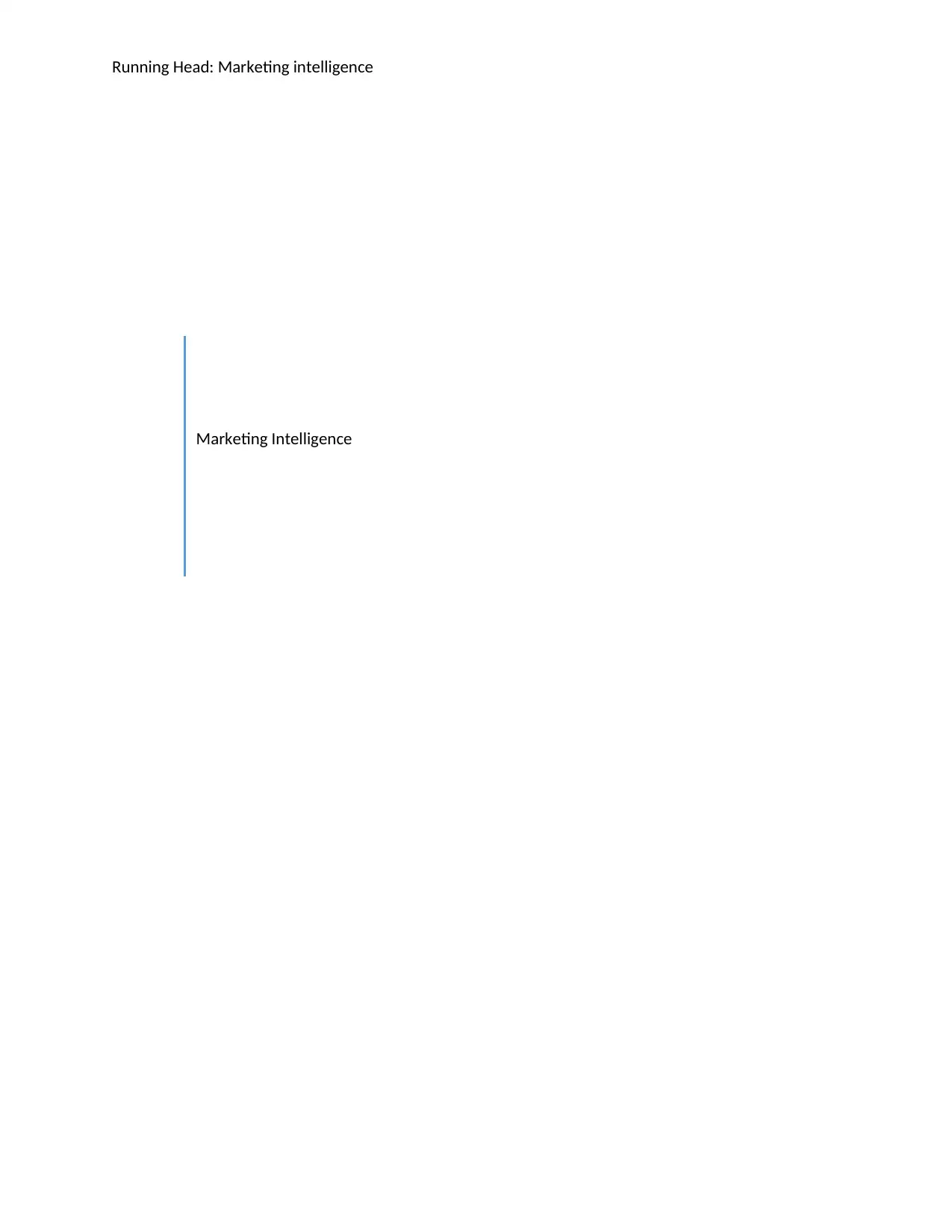
Running Head: Marketing intelligence
Marketing Intelligence
Marketing Intelligence
Paraphrase This Document
Need a fresh take? Get an instant paraphrase of this document with our AI Paraphraser
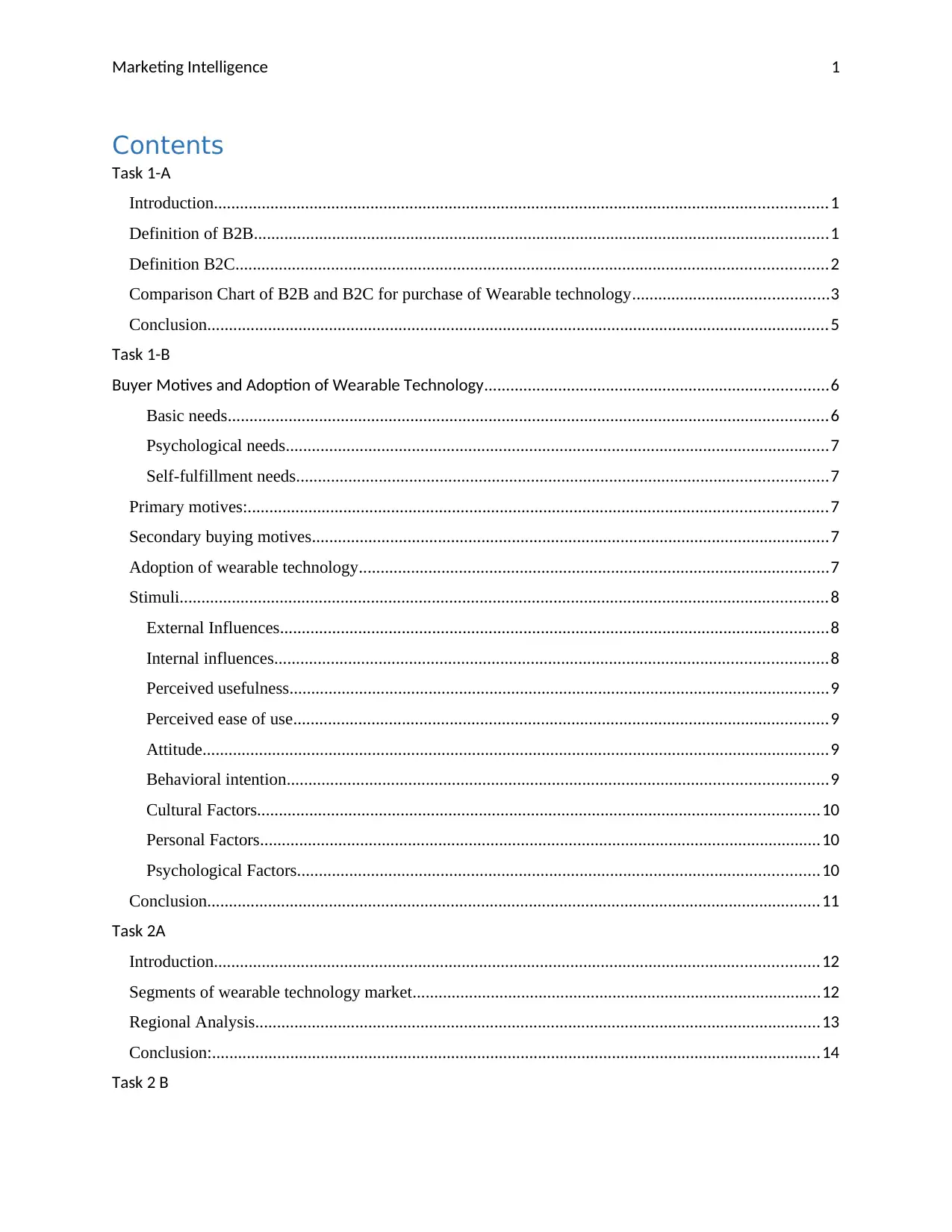
Marketing Intelligence 1
Contents
Task 1-A
Introduction.............................................................................................................................................1
Definition of B2B....................................................................................................................................1
Definition B2C........................................................................................................................................2
Comparison Chart of B2B and B2C for purchase of Wearable technology.............................................3
Conclusion...............................................................................................................................................5
Task 1-B
Buyer Motives and Adoption of Wearable Technology...............................................................................6
Basic needs..........................................................................................................................................6
Psychological needs.............................................................................................................................7
Self-fulfillment needs..........................................................................................................................7
Primary motives:.....................................................................................................................................7
Secondary buying motives.......................................................................................................................7
Adoption of wearable technology............................................................................................................7
Stimuli.....................................................................................................................................................8
External Influences..............................................................................................................................8
Internal influences...............................................................................................................................8
Perceived usefulness............................................................................................................................9
Perceived ease of use...........................................................................................................................9
Attitude................................................................................................................................................9
Behavioral intention............................................................................................................................9
Cultural Factors.................................................................................................................................10
Personal Factors.................................................................................................................................10
Psychological Factors........................................................................................................................10
Conclusion.............................................................................................................................................11
Task 2A
Introduction...........................................................................................................................................12
Segments of wearable technology market..............................................................................................12
Regional Analysis..................................................................................................................................13
Conclusion:............................................................................................................................................14
Task 2 B
Contents
Task 1-A
Introduction.............................................................................................................................................1
Definition of B2B....................................................................................................................................1
Definition B2C........................................................................................................................................2
Comparison Chart of B2B and B2C for purchase of Wearable technology.............................................3
Conclusion...............................................................................................................................................5
Task 1-B
Buyer Motives and Adoption of Wearable Technology...............................................................................6
Basic needs..........................................................................................................................................6
Psychological needs.............................................................................................................................7
Self-fulfillment needs..........................................................................................................................7
Primary motives:.....................................................................................................................................7
Secondary buying motives.......................................................................................................................7
Adoption of wearable technology............................................................................................................7
Stimuli.....................................................................................................................................................8
External Influences..............................................................................................................................8
Internal influences...............................................................................................................................8
Perceived usefulness............................................................................................................................9
Perceived ease of use...........................................................................................................................9
Attitude................................................................................................................................................9
Behavioral intention............................................................................................................................9
Cultural Factors.................................................................................................................................10
Personal Factors.................................................................................................................................10
Psychological Factors........................................................................................................................10
Conclusion.............................................................................................................................................11
Task 2A
Introduction...........................................................................................................................................12
Segments of wearable technology market..............................................................................................12
Regional Analysis..................................................................................................................................13
Conclusion:............................................................................................................................................14
Task 2 B
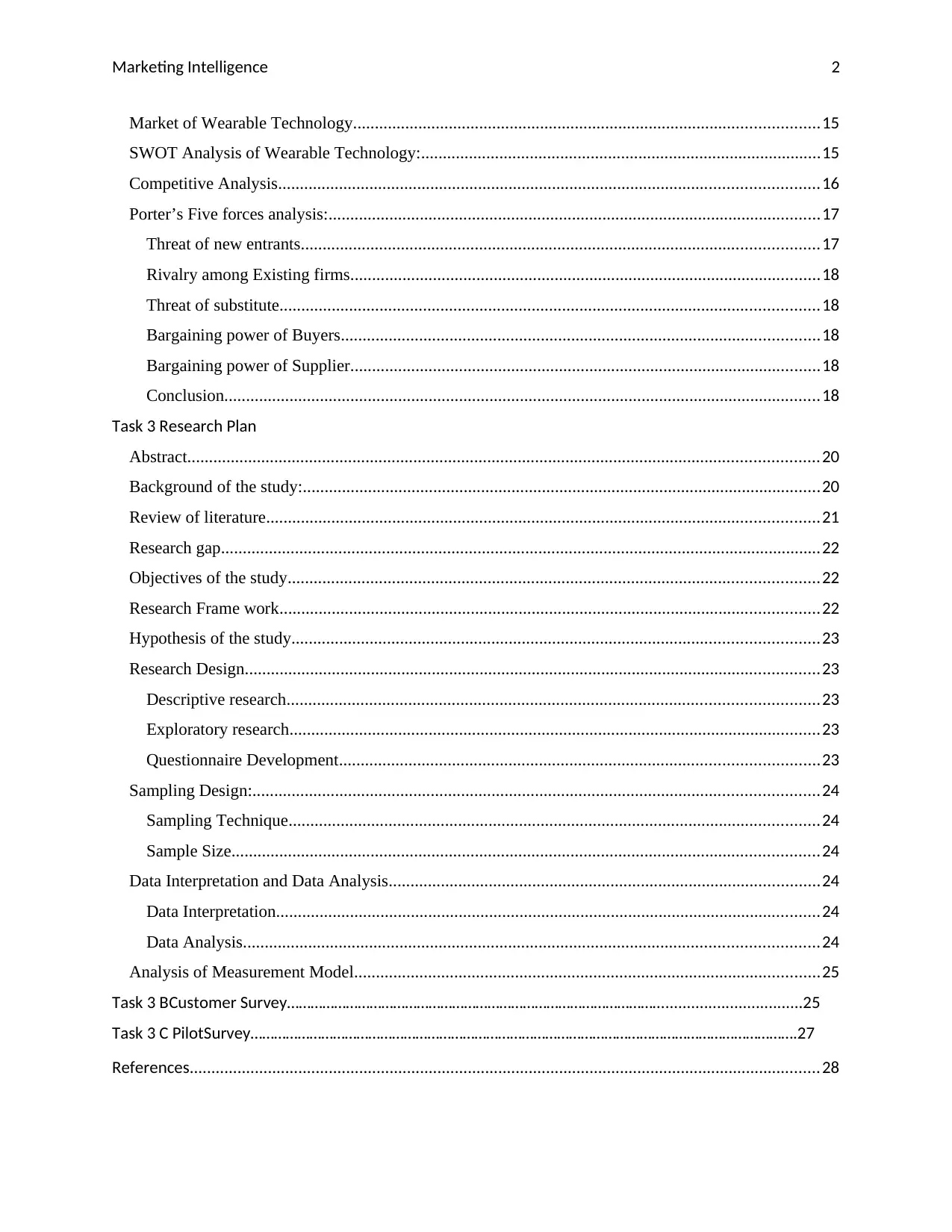
Marketing Intelligence 2
Market of Wearable Technology...........................................................................................................15
SWOT Analysis of Wearable Technology:............................................................................................15
Competitive Analysis............................................................................................................................16
Porter’s Five forces analysis:.................................................................................................................17
Threat of new entrants.......................................................................................................................17
Rivalry among Existing firms............................................................................................................18
Threat of substitute............................................................................................................................18
Bargaining power of Buyers..............................................................................................................18
Bargaining power of Supplier............................................................................................................18
Conclusion.........................................................................................................................................18
Task 3 Research Plan
Abstract.................................................................................................................................................20
Background of the study:.......................................................................................................................20
Review of literature...............................................................................................................................21
Research gap..........................................................................................................................................22
Objectives of the study..........................................................................................................................22
Research Frame work............................................................................................................................22
Hypothesis of the study.........................................................................................................................23
Research Design....................................................................................................................................23
Descriptive research..........................................................................................................................23
Exploratory research..........................................................................................................................23
Questionnaire Development..............................................................................................................23
Sampling Design:..................................................................................................................................24
Sampling Technique..........................................................................................................................24
Sample Size.......................................................................................................................................24
Data Interpretation and Data Analysis...................................................................................................24
Data Interpretation.............................................................................................................................24
Data Analysis....................................................................................................................................24
Analysis of Measurement Model...........................................................................................................25
Task 3 BCustomer Survey……………………………………………………………………………………................................25
Task 3 C PilotSurvey………………………………………………………………………………………………………………………….27
References.................................................................................................................................................28
Market of Wearable Technology...........................................................................................................15
SWOT Analysis of Wearable Technology:............................................................................................15
Competitive Analysis............................................................................................................................16
Porter’s Five forces analysis:.................................................................................................................17
Threat of new entrants.......................................................................................................................17
Rivalry among Existing firms............................................................................................................18
Threat of substitute............................................................................................................................18
Bargaining power of Buyers..............................................................................................................18
Bargaining power of Supplier............................................................................................................18
Conclusion.........................................................................................................................................18
Task 3 Research Plan
Abstract.................................................................................................................................................20
Background of the study:.......................................................................................................................20
Review of literature...............................................................................................................................21
Research gap..........................................................................................................................................22
Objectives of the study..........................................................................................................................22
Research Frame work............................................................................................................................22
Hypothesis of the study.........................................................................................................................23
Research Design....................................................................................................................................23
Descriptive research..........................................................................................................................23
Exploratory research..........................................................................................................................23
Questionnaire Development..............................................................................................................23
Sampling Design:..................................................................................................................................24
Sampling Technique..........................................................................................................................24
Sample Size.......................................................................................................................................24
Data Interpretation and Data Analysis...................................................................................................24
Data Interpretation.............................................................................................................................24
Data Analysis....................................................................................................................................24
Analysis of Measurement Model...........................................................................................................25
Task 3 BCustomer Survey……………………………………………………………………………………................................25
Task 3 C PilotSurvey………………………………………………………………………………………………………………………….27
References.................................................................................................................................................28
⊘ This is a preview!⊘
Do you want full access?
Subscribe today to unlock all pages.

Trusted by 1+ million students worldwide
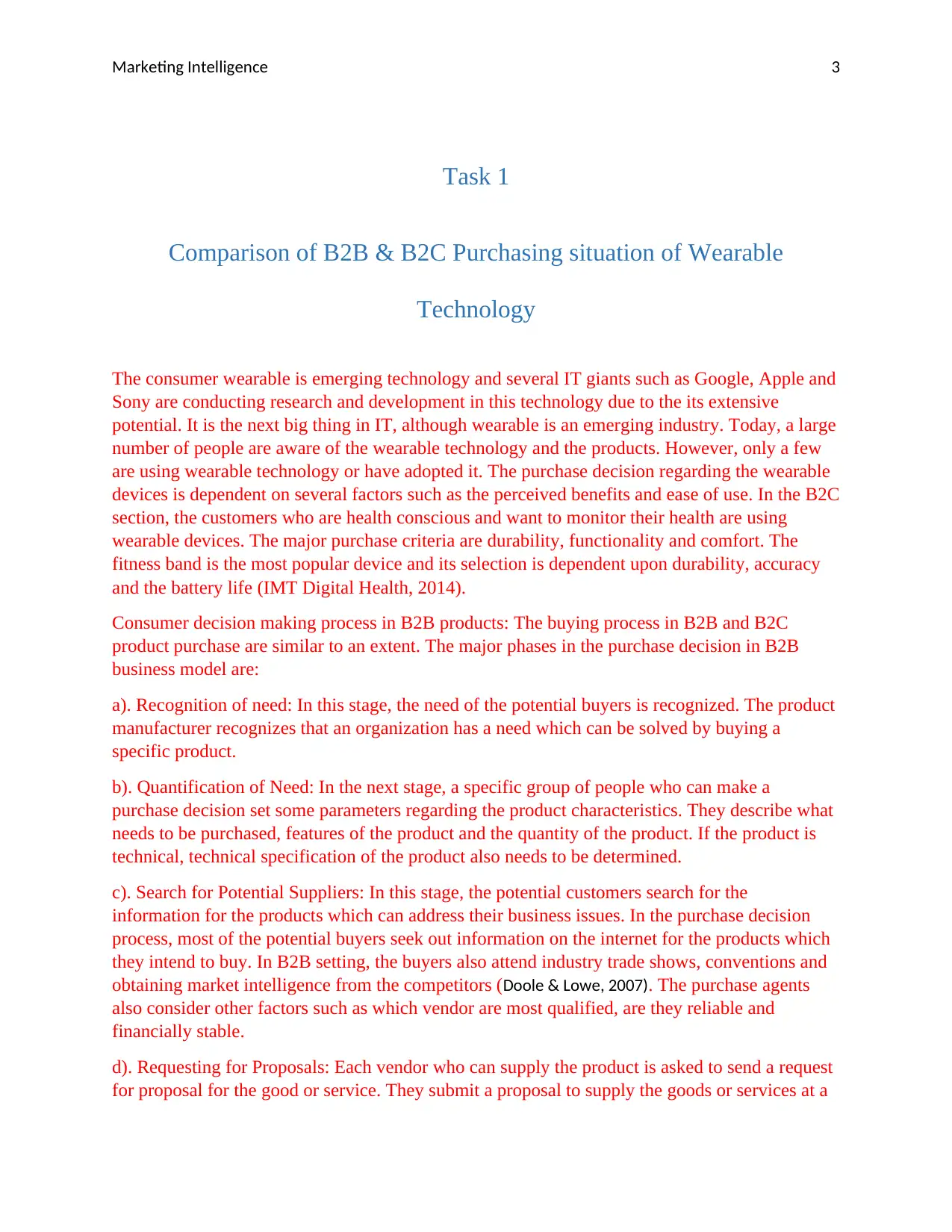
Marketing Intelligence 3
Task 1
Comparison of B2B & B2C Purchasing situation of Wearable
Technology
The consumer wearable is emerging technology and several IT giants such as Google, Apple and
Sony are conducting research and development in this technology due to the its extensive
potential. It is the next big thing in IT, although wearable is an emerging industry. Today, a large
number of people are aware of the wearable technology and the products. However, only a few
are using wearable technology or have adopted it. The purchase decision regarding the wearable
devices is dependent on several factors such as the perceived benefits and ease of use. In the B2C
section, the customers who are health conscious and want to monitor their health are using
wearable devices. The major purchase criteria are durability, functionality and comfort. The
fitness band is the most popular device and its selection is dependent upon durability, accuracy
and the battery life (IMT Digital Health, 2014).
Consumer decision making process in B2B products: The buying process in B2B and B2C
product purchase are similar to an extent. The major phases in the purchase decision in B2B
business model are:
a). Recognition of need: In this stage, the need of the potential buyers is recognized. The product
manufacturer recognizes that an organization has a need which can be solved by buying a
specific product.
b). Quantification of Need: In the next stage, a specific group of people who can make a
purchase decision set some parameters regarding the product characteristics. They describe what
needs to be purchased, features of the product and the quantity of the product. If the product is
technical, technical specification of the product also needs to be determined.
c). Search for Potential Suppliers: In this stage, the potential customers search for the
information for the products which can address their business issues. In the purchase decision
process, most of the potential buyers seek out information on the internet for the products which
they intend to buy. In B2B setting, the buyers also attend industry trade shows, conventions and
obtaining market intelligence from the competitors (Doole & Lowe, 2007). The purchase agents
also consider other factors such as which vendor are most qualified, are they reliable and
financially stable.
d). Requesting for Proposals: Each vendor who can supply the product is asked to send a request
for proposal for the good or service. They submit a proposal to supply the goods or services at a
Task 1
Comparison of B2B & B2C Purchasing situation of Wearable
Technology
The consumer wearable is emerging technology and several IT giants such as Google, Apple and
Sony are conducting research and development in this technology due to the its extensive
potential. It is the next big thing in IT, although wearable is an emerging industry. Today, a large
number of people are aware of the wearable technology and the products. However, only a few
are using wearable technology or have adopted it. The purchase decision regarding the wearable
devices is dependent on several factors such as the perceived benefits and ease of use. In the B2C
section, the customers who are health conscious and want to monitor their health are using
wearable devices. The major purchase criteria are durability, functionality and comfort. The
fitness band is the most popular device and its selection is dependent upon durability, accuracy
and the battery life (IMT Digital Health, 2014).
Consumer decision making process in B2B products: The buying process in B2B and B2C
product purchase are similar to an extent. The major phases in the purchase decision in B2B
business model are:
a). Recognition of need: In this stage, the need of the potential buyers is recognized. The product
manufacturer recognizes that an organization has a need which can be solved by buying a
specific product.
b). Quantification of Need: In the next stage, a specific group of people who can make a
purchase decision set some parameters regarding the product characteristics. They describe what
needs to be purchased, features of the product and the quantity of the product. If the product is
technical, technical specification of the product also needs to be determined.
c). Search for Potential Suppliers: In this stage, the potential customers search for the
information for the products which can address their business issues. In the purchase decision
process, most of the potential buyers seek out information on the internet for the products which
they intend to buy. In B2B setting, the buyers also attend industry trade shows, conventions and
obtaining market intelligence from the competitors (Doole & Lowe, 2007). The purchase agents
also consider other factors such as which vendor are most qualified, are they reliable and
financially stable.
d). Requesting for Proposals: Each vendor who can supply the product is asked to send a request
for proposal for the good or service. They submit a proposal to supply the goods or services at a
Paraphrase This Document
Need a fresh take? Get an instant paraphrase of this document with our AI Paraphraser
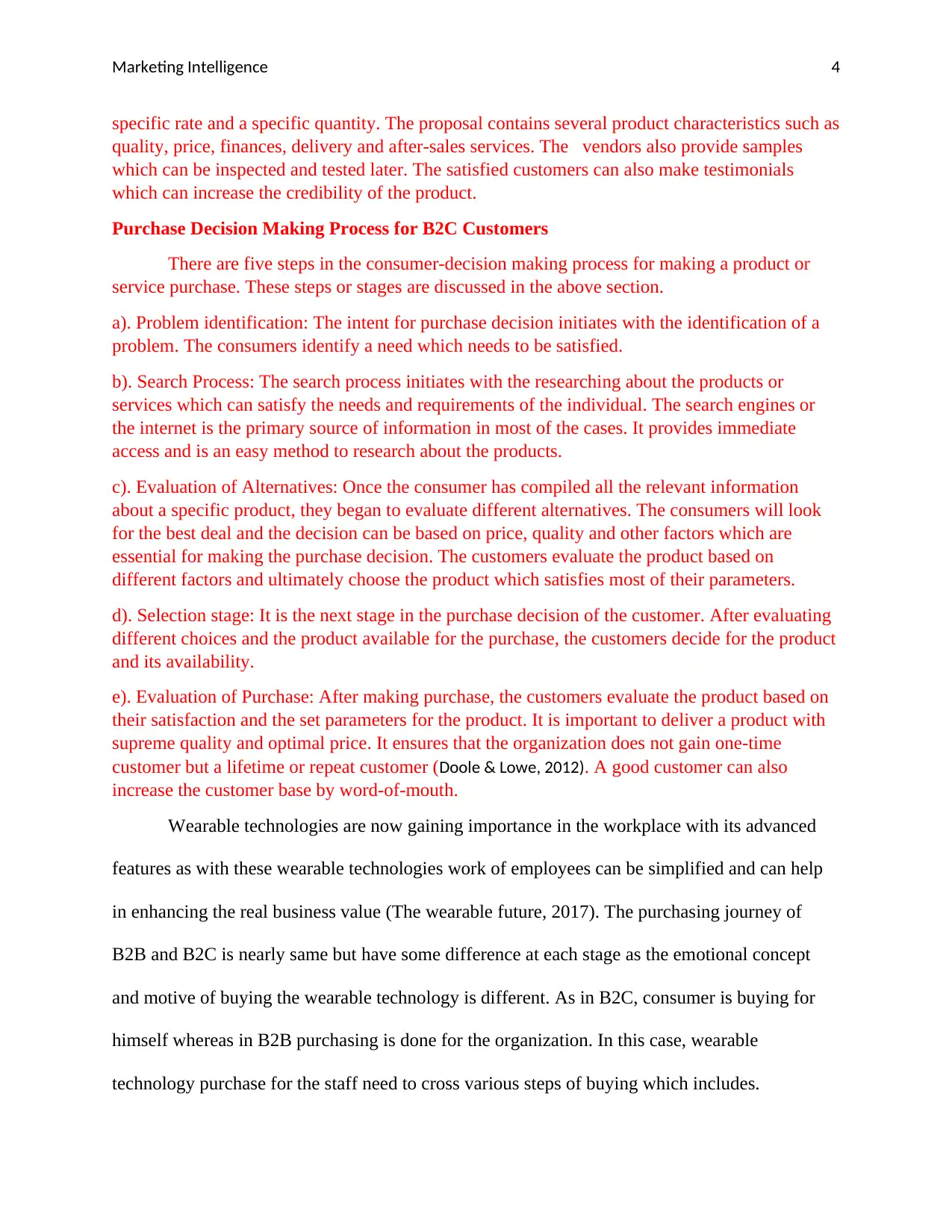
Marketing Intelligence 4
specific rate and a specific quantity. The proposal contains several product characteristics such as
quality, price, finances, delivery and after-sales services. The vendors also provide samples
which can be inspected and tested later. The satisfied customers can also make testimonials
which can increase the credibility of the product.
Purchase Decision Making Process for B2C Customers
There are five steps in the consumer-decision making process for making a product or
service purchase. These steps or stages are discussed in the above section.
a). Problem identification: The intent for purchase decision initiates with the identification of a
problem. The consumers identify a need which needs to be satisfied.
b). Search Process: The search process initiates with the researching about the products or
services which can satisfy the needs and requirements of the individual. The search engines or
the internet is the primary source of information in most of the cases. It provides immediate
access and is an easy method to research about the products.
c). Evaluation of Alternatives: Once the consumer has compiled all the relevant information
about a specific product, they began to evaluate different alternatives. The consumers will look
for the best deal and the decision can be based on price, quality and other factors which are
essential for making the purchase decision. The customers evaluate the product based on
different factors and ultimately choose the product which satisfies most of their parameters.
d). Selection stage: It is the next stage in the purchase decision of the customer. After evaluating
different choices and the product available for the purchase, the customers decide for the product
and its availability.
e). Evaluation of Purchase: After making purchase, the customers evaluate the product based on
their satisfaction and the set parameters for the product. It is important to deliver a product with
supreme quality and optimal price. It ensures that the organization does not gain one-time
customer but a lifetime or repeat customer (Doole & Lowe, 2012). A good customer can also
increase the customer base by word-of-mouth.
Wearable technologies are now gaining importance in the workplace with its advanced
features as with these wearable technologies work of employees can be simplified and can help
in enhancing the real business value (The wearable future, 2017). The purchasing journey of
B2B and B2C is nearly same but have some difference at each stage as the emotional concept
and motive of buying the wearable technology is different. As in B2C, consumer is buying for
himself whereas in B2B purchasing is done for the organization. In this case, wearable
technology purchase for the staff need to cross various steps of buying which includes.
specific rate and a specific quantity. The proposal contains several product characteristics such as
quality, price, finances, delivery and after-sales services. The vendors also provide samples
which can be inspected and tested later. The satisfied customers can also make testimonials
which can increase the credibility of the product.
Purchase Decision Making Process for B2C Customers
There are five steps in the consumer-decision making process for making a product or
service purchase. These steps or stages are discussed in the above section.
a). Problem identification: The intent for purchase decision initiates with the identification of a
problem. The consumers identify a need which needs to be satisfied.
b). Search Process: The search process initiates with the researching about the products or
services which can satisfy the needs and requirements of the individual. The search engines or
the internet is the primary source of information in most of the cases. It provides immediate
access and is an easy method to research about the products.
c). Evaluation of Alternatives: Once the consumer has compiled all the relevant information
about a specific product, they began to evaluate different alternatives. The consumers will look
for the best deal and the decision can be based on price, quality and other factors which are
essential for making the purchase decision. The customers evaluate the product based on
different factors and ultimately choose the product which satisfies most of their parameters.
d). Selection stage: It is the next stage in the purchase decision of the customer. After evaluating
different choices and the product available for the purchase, the customers decide for the product
and its availability.
e). Evaluation of Purchase: After making purchase, the customers evaluate the product based on
their satisfaction and the set parameters for the product. It is important to deliver a product with
supreme quality and optimal price. It ensures that the organization does not gain one-time
customer but a lifetime or repeat customer (Doole & Lowe, 2012). A good customer can also
increase the customer base by word-of-mouth.
Wearable technologies are now gaining importance in the workplace with its advanced
features as with these wearable technologies work of employees can be simplified and can help
in enhancing the real business value (The wearable future, 2017). The purchasing journey of
B2B and B2C is nearly same but have some difference at each stage as the emotional concept
and motive of buying the wearable technology is different. As in B2C, consumer is buying for
himself whereas in B2B purchasing is done for the organization. In this case, wearable
technology purchase for the staff need to cross various steps of buying which includes.
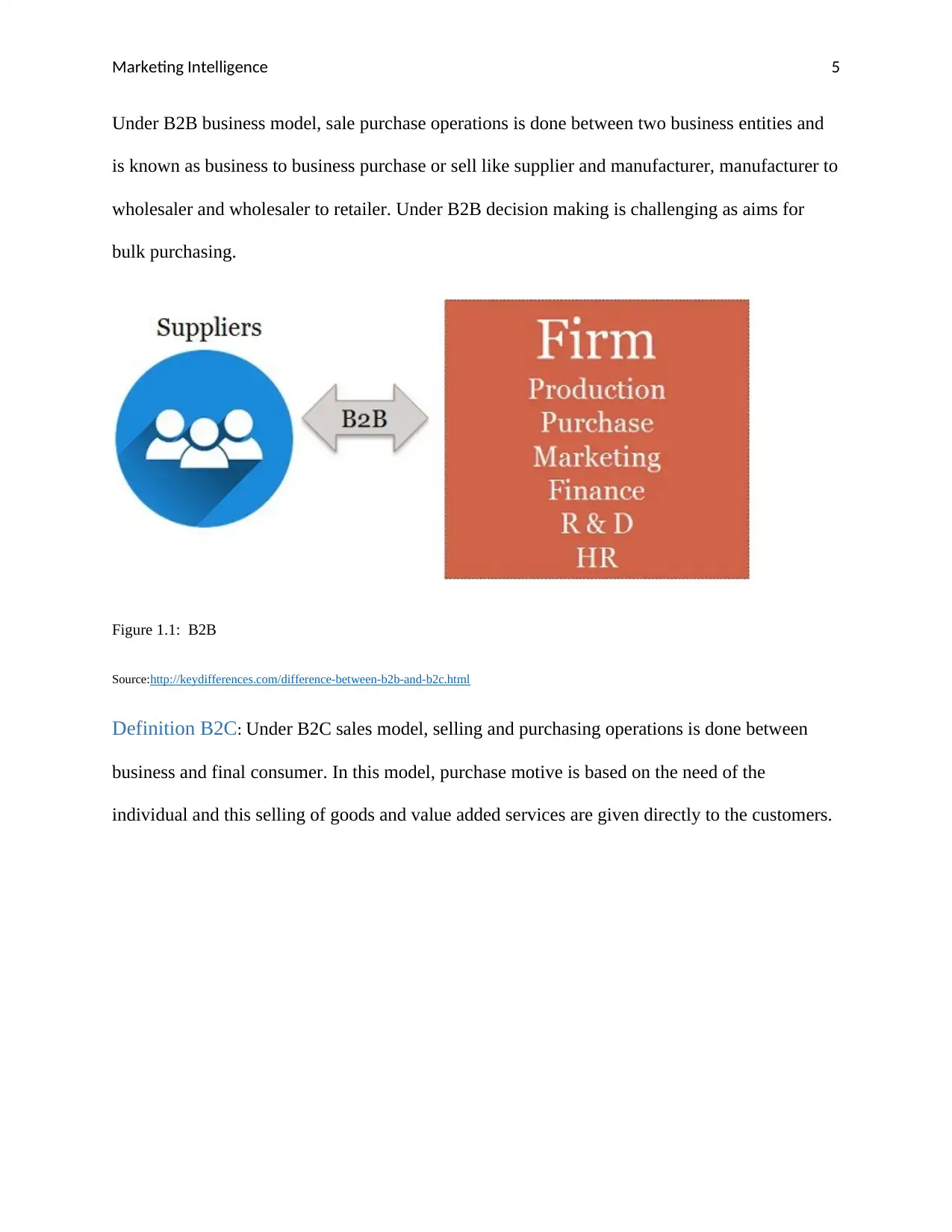
Marketing Intelligence 5
Under B2B business model, sale purchase operations is done between two business entities and
is known as business to business purchase or sell like supplier and manufacturer, manufacturer to
wholesaler and wholesaler to retailer. Under B2B decision making is challenging as aims for
bulk purchasing.
Figure 1.1: B2B
Source:http://keydifferences.com/difference-between-b2b-and-b2c.html
Definition B2C: Under B2C sales model, selling and purchasing operations is done between
business and final consumer. In this model, purchase motive is based on the need of the
individual and this selling of goods and value added services are given directly to the customers.
Under B2B business model, sale purchase operations is done between two business entities and
is known as business to business purchase or sell like supplier and manufacturer, manufacturer to
wholesaler and wholesaler to retailer. Under B2B decision making is challenging as aims for
bulk purchasing.
Figure 1.1: B2B
Source:http://keydifferences.com/difference-between-b2b-and-b2c.html
Definition B2C: Under B2C sales model, selling and purchasing operations is done between
business and final consumer. In this model, purchase motive is based on the need of the
individual and this selling of goods and value added services are given directly to the customers.
⊘ This is a preview!⊘
Do you want full access?
Subscribe today to unlock all pages.

Trusted by 1+ million students worldwide
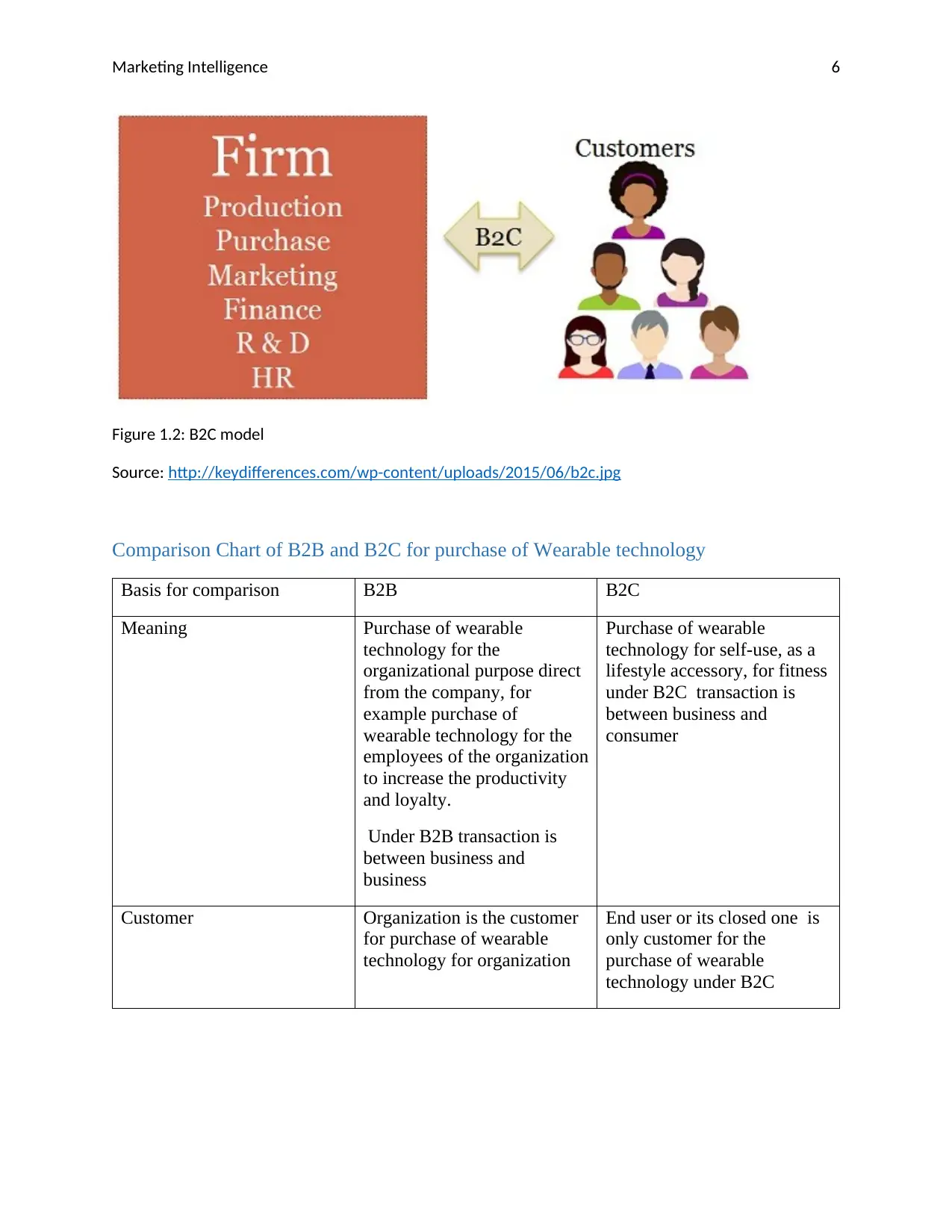
Marketing Intelligence 6
Figure 1.2: B2C model
Source: http://keydifferences.com/wp-content/uploads/2015/06/b2c.jpg
Comparison Chart of B2B and B2C for purchase of Wearable technology
Basis for comparison B2B B2C
Meaning Purchase of wearable
technology for the
organizational purpose direct
from the company, for
example purchase of
wearable technology for the
employees of the organization
to increase the productivity
and loyalty.
Under B2B transaction is
between business and
business
Purchase of wearable
technology for self-use, as a
lifestyle accessory, for fitness
under B2C transaction is
between business and
consumer
Customer Organization is the customer
for purchase of wearable
technology for organization
End user or its closed one is
only customer for the
purchase of wearable
technology under B2C
Figure 1.2: B2C model
Source: http://keydifferences.com/wp-content/uploads/2015/06/b2c.jpg
Comparison Chart of B2B and B2C for purchase of Wearable technology
Basis for comparison B2B B2C
Meaning Purchase of wearable
technology for the
organizational purpose direct
from the company, for
example purchase of
wearable technology for the
employees of the organization
to increase the productivity
and loyalty.
Under B2B transaction is
between business and
business
Purchase of wearable
technology for self-use, as a
lifestyle accessory, for fitness
under B2C transaction is
between business and
consumer
Customer Organization is the customer
for purchase of wearable
technology for organization
End user or its closed one is
only customer for the
purchase of wearable
technology under B2C
Paraphrase This Document
Need a fresh take? Get an instant paraphrase of this document with our AI Paraphraser
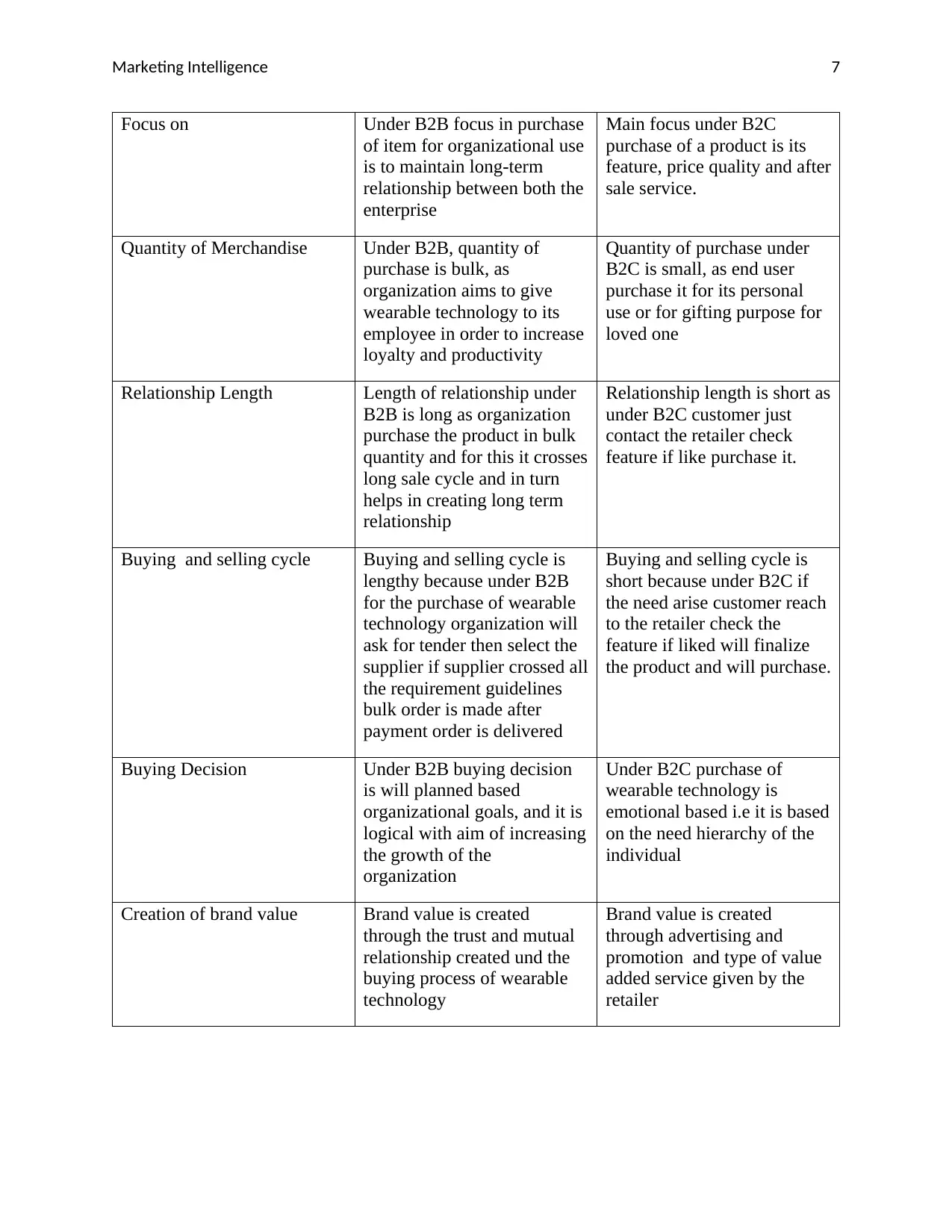
Marketing Intelligence 7
Focus on Under B2B focus in purchase
of item for organizational use
is to maintain long-term
relationship between both the
enterprise
Main focus under B2C
purchase of a product is its
feature, price quality and after
sale service.
Quantity of Merchandise Under B2B, quantity of
purchase is bulk, as
organization aims to give
wearable technology to its
employee in order to increase
loyalty and productivity
Quantity of purchase under
B2C is small, as end user
purchase it for its personal
use or for gifting purpose for
loved one
Relationship Length Length of relationship under
B2B is long as organization
purchase the product in bulk
quantity and for this it crosses
long sale cycle and in turn
helps in creating long term
relationship
Relationship length is short as
under B2C customer just
contact the retailer check
feature if like purchase it.
Buying and selling cycle Buying and selling cycle is
lengthy because under B2B
for the purchase of wearable
technology organization will
ask for tender then select the
supplier if supplier crossed all
the requirement guidelines
bulk order is made after
payment order is delivered
Buying and selling cycle is
short because under B2C if
the need arise customer reach
to the retailer check the
feature if liked will finalize
the product and will purchase.
Buying Decision Under B2B buying decision
is will planned based
organizational goals, and it is
logical with aim of increasing
the growth of the
organization
Under B2C purchase of
wearable technology is
emotional based i.e it is based
on the need hierarchy of the
individual
Creation of brand value Brand value is created
through the trust and mutual
relationship created und the
buying process of wearable
technology
Brand value is created
through advertising and
promotion and type of value
added service given by the
retailer
Focus on Under B2B focus in purchase
of item for organizational use
is to maintain long-term
relationship between both the
enterprise
Main focus under B2C
purchase of a product is its
feature, price quality and after
sale service.
Quantity of Merchandise Under B2B, quantity of
purchase is bulk, as
organization aims to give
wearable technology to its
employee in order to increase
loyalty and productivity
Quantity of purchase under
B2C is small, as end user
purchase it for its personal
use or for gifting purpose for
loved one
Relationship Length Length of relationship under
B2B is long as organization
purchase the product in bulk
quantity and for this it crosses
long sale cycle and in turn
helps in creating long term
relationship
Relationship length is short as
under B2C customer just
contact the retailer check
feature if like purchase it.
Buying and selling cycle Buying and selling cycle is
lengthy because under B2B
for the purchase of wearable
technology organization will
ask for tender then select the
supplier if supplier crossed all
the requirement guidelines
bulk order is made after
payment order is delivered
Buying and selling cycle is
short because under B2C if
the need arise customer reach
to the retailer check the
feature if liked will finalize
the product and will purchase.
Buying Decision Under B2B buying decision
is will planned based
organizational goals, and it is
logical with aim of increasing
the growth of the
organization
Under B2C purchase of
wearable technology is
emotional based i.e it is based
on the need hierarchy of the
individual
Creation of brand value Brand value is created
through the trust and mutual
relationship created und the
buying process of wearable
technology
Brand value is created
through advertising and
promotion and type of value
added service given by the
retailer
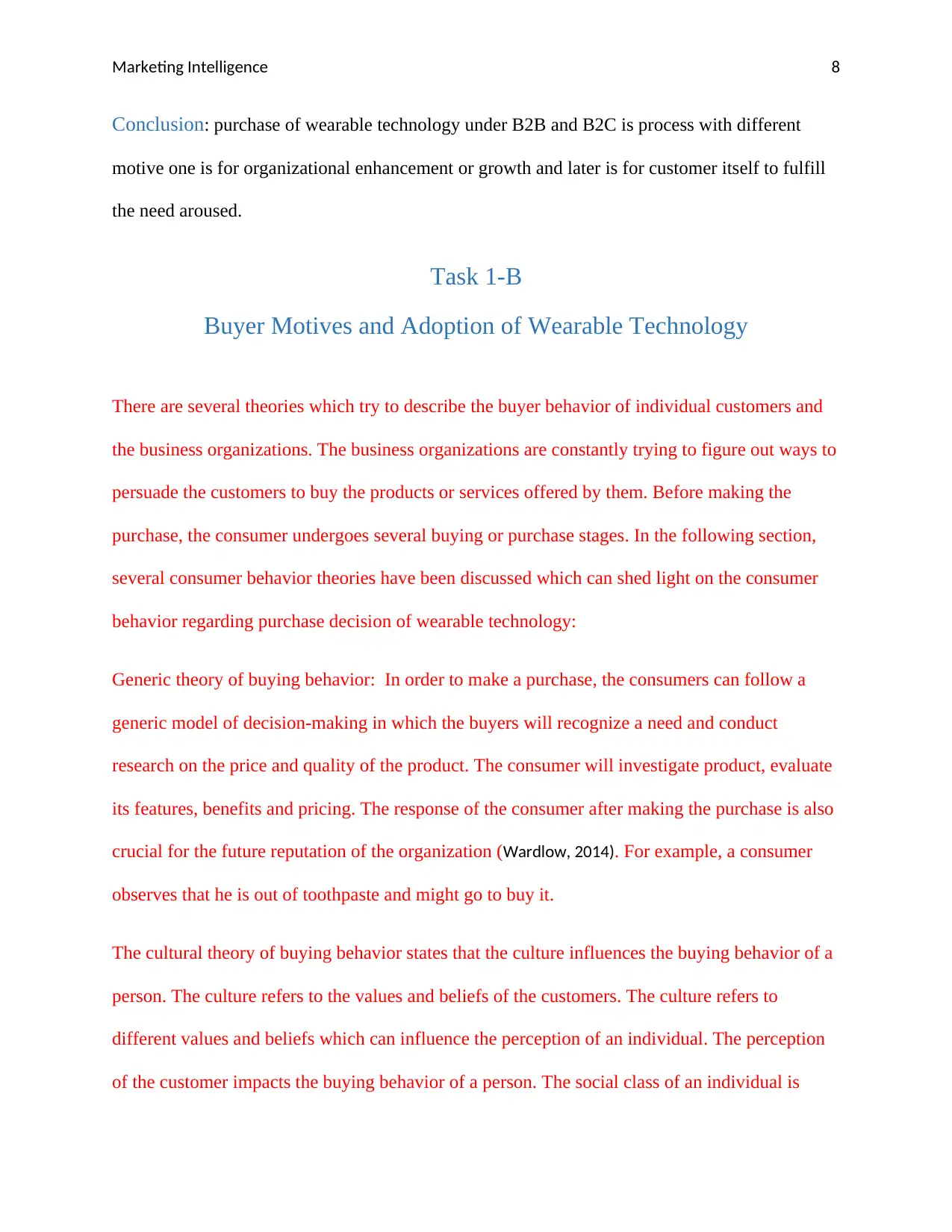
Marketing Intelligence 8
Conclusion: purchase of wearable technology under B2B and B2C is process with different
motive one is for organizational enhancement or growth and later is for customer itself to fulfill
the need aroused.
Task 1-B
Buyer Motives and Adoption of Wearable Technology
There are several theories which try to describe the buyer behavior of individual customers and
the business organizations. The business organizations are constantly trying to figure out ways to
persuade the customers to buy the products or services offered by them. Before making the
purchase, the consumer undergoes several buying or purchase stages. In the following section,
several consumer behavior theories have been discussed which can shed light on the consumer
behavior regarding purchase decision of wearable technology:
Generic theory of buying behavior: In order to make a purchase, the consumers can follow a
generic model of decision-making in which the buyers will recognize a need and conduct
research on the price and quality of the product. The consumer will investigate product, evaluate
its features, benefits and pricing. The response of the consumer after making the purchase is also
crucial for the future reputation of the organization (Wardlow, 2014). For example, a consumer
observes that he is out of toothpaste and might go to buy it.
The cultural theory of buying behavior states that the culture influences the buying behavior of a
person. The culture refers to the values and beliefs of the customers. The culture refers to
different values and beliefs which can influence the perception of an individual. The perception
of the customer impacts the buying behavior of a person. The social class of an individual is
Conclusion: purchase of wearable technology under B2B and B2C is process with different
motive one is for organizational enhancement or growth and later is for customer itself to fulfill
the need aroused.
Task 1-B
Buyer Motives and Adoption of Wearable Technology
There are several theories which try to describe the buyer behavior of individual customers and
the business organizations. The business organizations are constantly trying to figure out ways to
persuade the customers to buy the products or services offered by them. Before making the
purchase, the consumer undergoes several buying or purchase stages. In the following section,
several consumer behavior theories have been discussed which can shed light on the consumer
behavior regarding purchase decision of wearable technology:
Generic theory of buying behavior: In order to make a purchase, the consumers can follow a
generic model of decision-making in which the buyers will recognize a need and conduct
research on the price and quality of the product. The consumer will investigate product, evaluate
its features, benefits and pricing. The response of the consumer after making the purchase is also
crucial for the future reputation of the organization (Wardlow, 2014). For example, a consumer
observes that he is out of toothpaste and might go to buy it.
The cultural theory of buying behavior states that the culture influences the buying behavior of a
person. The culture refers to the values and beliefs of the customers. The culture refers to
different values and beliefs which can influence the perception of an individual. The perception
of the customer impacts the buying behavior of a person. The social class of an individual is
⊘ This is a preview!⊘
Do you want full access?
Subscribe today to unlock all pages.

Trusted by 1+ million students worldwide
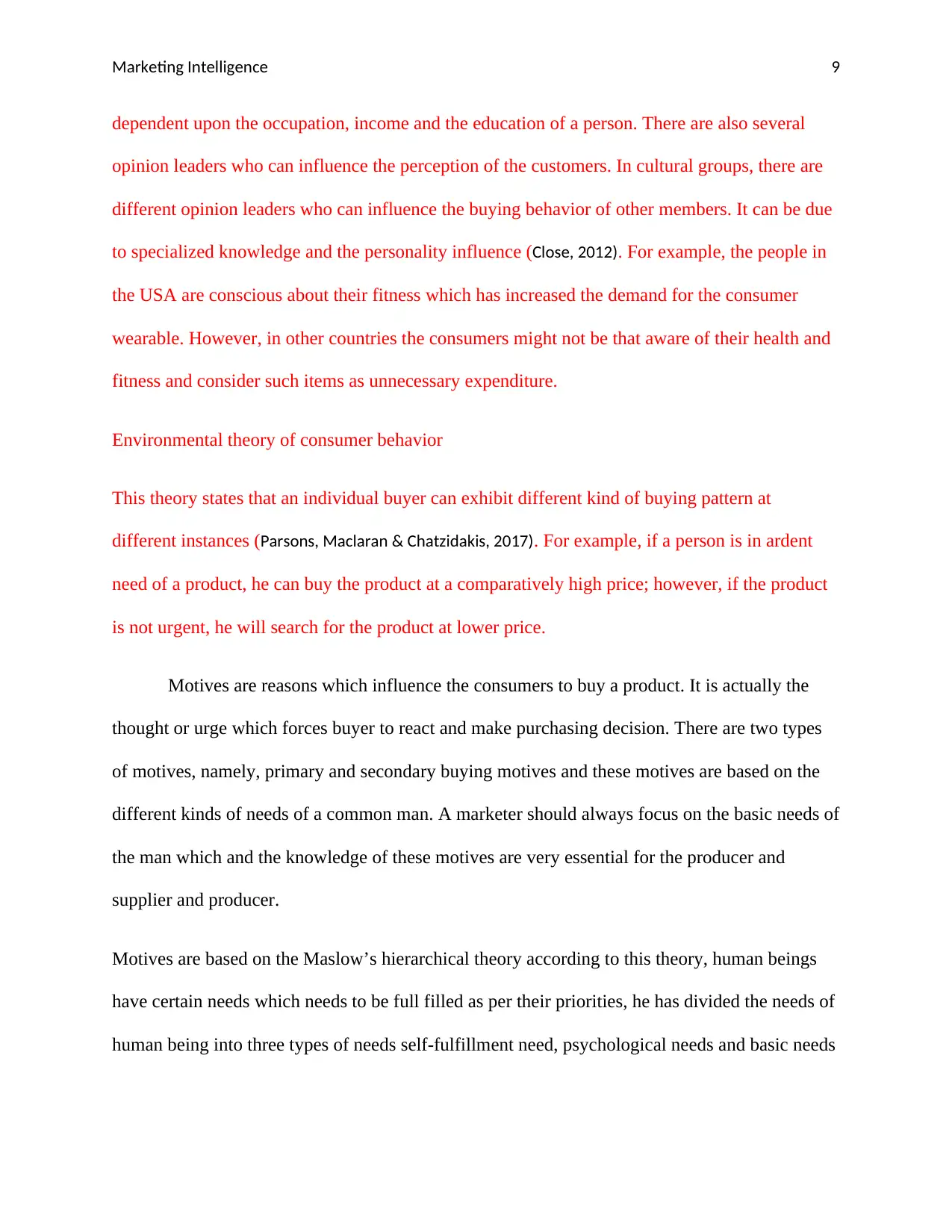
Marketing Intelligence 9
dependent upon the occupation, income and the education of a person. There are also several
opinion leaders who can influence the perception of the customers. In cultural groups, there are
different opinion leaders who can influence the buying behavior of other members. It can be due
to specialized knowledge and the personality influence (Close, 2012). For example, the people in
the USA are conscious about their fitness which has increased the demand for the consumer
wearable. However, in other countries the consumers might not be that aware of their health and
fitness and consider such items as unnecessary expenditure.
Environmental theory of consumer behavior
This theory states that an individual buyer can exhibit different kind of buying pattern at
different instances (Parsons, Maclaran & Chatzidakis, 2017). For example, if a person is in ardent
need of a product, he can buy the product at a comparatively high price; however, if the product
is not urgent, he will search for the product at lower price.
Motives are reasons which influence the consumers to buy a product. It is actually the
thought or urge which forces buyer to react and make purchasing decision. There are two types
of motives, namely, primary and secondary buying motives and these motives are based on the
different kinds of needs of a common man. A marketer should always focus on the basic needs of
the man which and the knowledge of these motives are very essential for the producer and
supplier and producer.
Motives are based on the Maslow’s hierarchical theory according to this theory, human beings
have certain needs which needs to be full filled as per their priorities, he has divided the needs of
human being into three types of needs self-fulfillment need, psychological needs and basic needs
dependent upon the occupation, income and the education of a person. There are also several
opinion leaders who can influence the perception of the customers. In cultural groups, there are
different opinion leaders who can influence the buying behavior of other members. It can be due
to specialized knowledge and the personality influence (Close, 2012). For example, the people in
the USA are conscious about their fitness which has increased the demand for the consumer
wearable. However, in other countries the consumers might not be that aware of their health and
fitness and consider such items as unnecessary expenditure.
Environmental theory of consumer behavior
This theory states that an individual buyer can exhibit different kind of buying pattern at
different instances (Parsons, Maclaran & Chatzidakis, 2017). For example, if a person is in ardent
need of a product, he can buy the product at a comparatively high price; however, if the product
is not urgent, he will search for the product at lower price.
Motives are reasons which influence the consumers to buy a product. It is actually the
thought or urge which forces buyer to react and make purchasing decision. There are two types
of motives, namely, primary and secondary buying motives and these motives are based on the
different kinds of needs of a common man. A marketer should always focus on the basic needs of
the man which and the knowledge of these motives are very essential for the producer and
supplier and producer.
Motives are based on the Maslow’s hierarchical theory according to this theory, human beings
have certain needs which needs to be full filled as per their priorities, he has divided the needs of
human being into three types of needs self-fulfillment need, psychological needs and basic needs
Paraphrase This Document
Need a fresh take? Get an instant paraphrase of this document with our AI Paraphraser
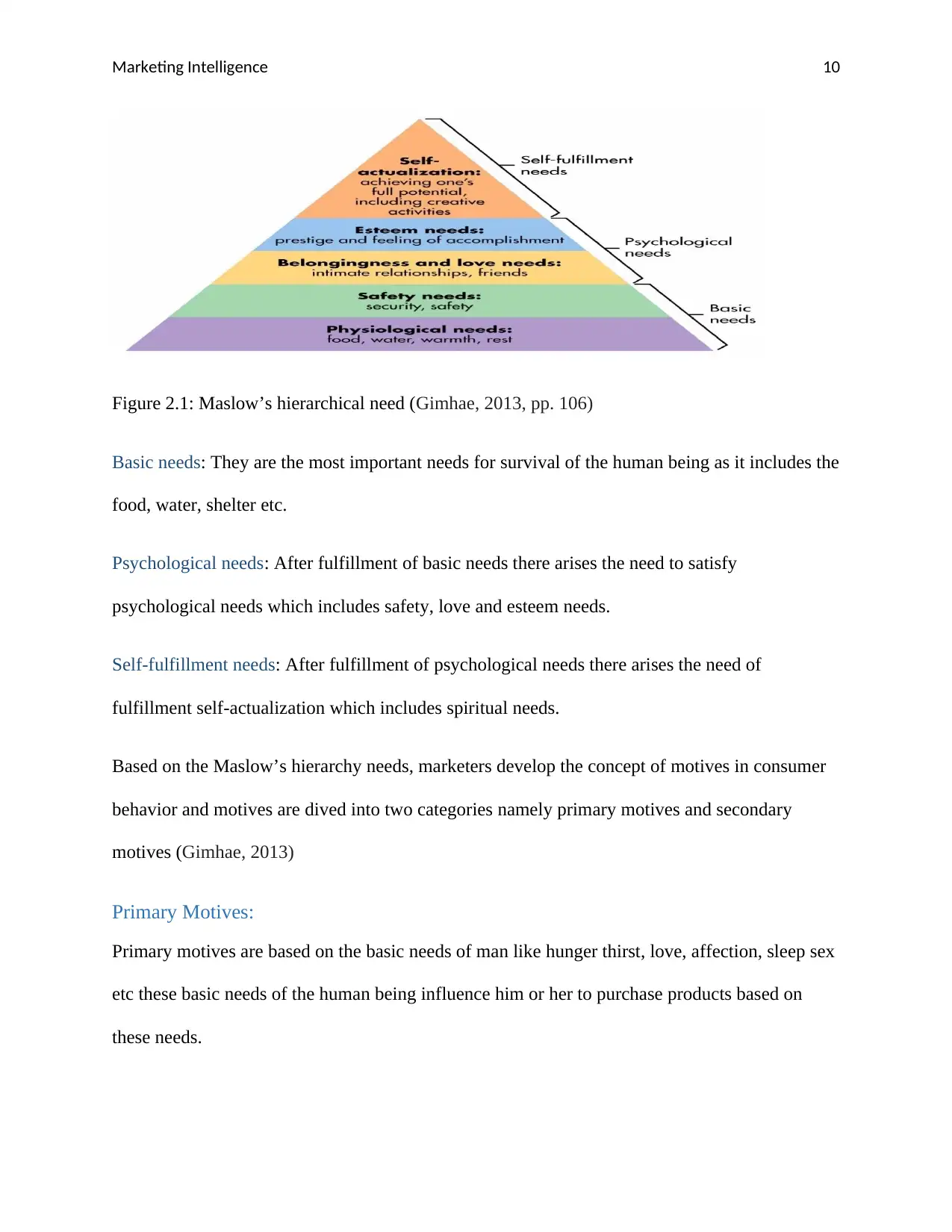
Marketing Intelligence 10
Figure 2.1: Maslow’s hierarchical need (Gimhae, 2013, pp. 106)
Basic needs: They are the most important needs for survival of the human being as it includes the
food, water, shelter etc.
Psychological needs: After fulfillment of basic needs there arises the need to satisfy
psychological needs which includes safety, love and esteem needs.
Self-fulfillment needs: After fulfillment of psychological needs there arises the need of
fulfillment self-actualization which includes spiritual needs.
Based on the Maslow’s hierarchy needs, marketers develop the concept of motives in consumer
behavior and motives are dived into two categories namely primary motives and secondary
motives (Gimhae, 2013)
Primary Motives:
Primary motives are based on the basic needs of man like hunger thirst, love, affection, sleep sex
etc these basic needs of the human being influence him or her to purchase products based on
these needs.
Figure 2.1: Maslow’s hierarchical need (Gimhae, 2013, pp. 106)
Basic needs: They are the most important needs for survival of the human being as it includes the
food, water, shelter etc.
Psychological needs: After fulfillment of basic needs there arises the need to satisfy
psychological needs which includes safety, love and esteem needs.
Self-fulfillment needs: After fulfillment of psychological needs there arises the need of
fulfillment self-actualization which includes spiritual needs.
Based on the Maslow’s hierarchy needs, marketers develop the concept of motives in consumer
behavior and motives are dived into two categories namely primary motives and secondary
motives (Gimhae, 2013)
Primary Motives:
Primary motives are based on the basic needs of man like hunger thirst, love, affection, sleep sex
etc these basic needs of the human being influence him or her to purchase products based on
these needs.
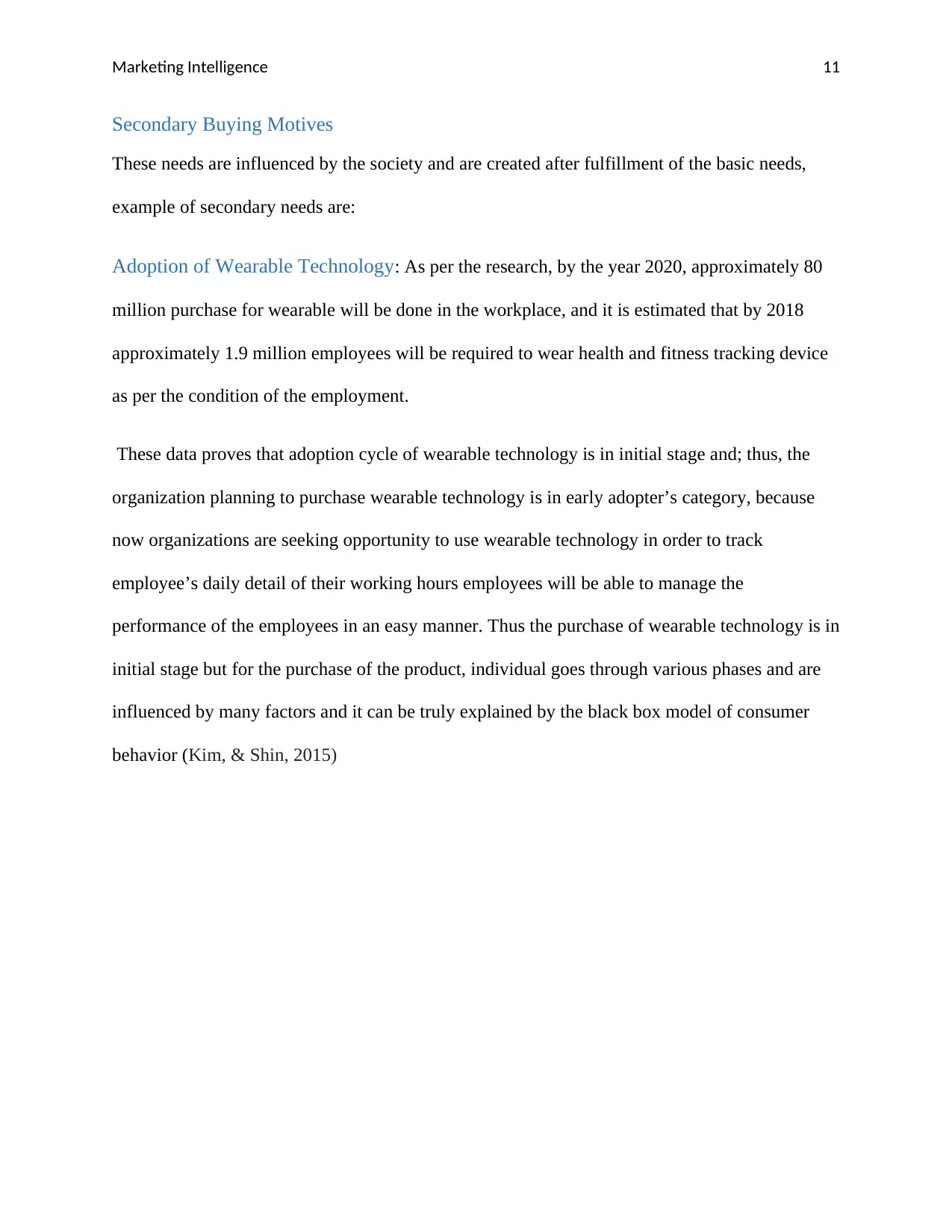
Marketing Intelligence 11
Secondary Buying Motives
These needs are influenced by the society and are created after fulfillment of the basic needs,
example of secondary needs are:
Adoption of Wearable Technology: As per the research, by the year 2020, approximately 80
million purchase for wearable will be done in the workplace, and it is estimated that by 2018
approximately 1.9 million employees will be required to wear health and fitness tracking device
as per the condition of the employment.
These data proves that adoption cycle of wearable technology is in initial stage and; thus, the
organization planning to purchase wearable technology is in early adopter’s category, because
now organizations are seeking opportunity to use wearable technology in order to track
employee’s daily detail of their working hours employees will be able to manage the
performance of the employees in an easy manner. Thus the purchase of wearable technology is in
initial stage but for the purchase of the product, individual goes through various phases and are
influenced by many factors and it can be truly explained by the black box model of consumer
behavior (Kim, & Shin, 2015)
Secondary Buying Motives
These needs are influenced by the society and are created after fulfillment of the basic needs,
example of secondary needs are:
Adoption of Wearable Technology: As per the research, by the year 2020, approximately 80
million purchase for wearable will be done in the workplace, and it is estimated that by 2018
approximately 1.9 million employees will be required to wear health and fitness tracking device
as per the condition of the employment.
These data proves that adoption cycle of wearable technology is in initial stage and; thus, the
organization planning to purchase wearable technology is in early adopter’s category, because
now organizations are seeking opportunity to use wearable technology in order to track
employee’s daily detail of their working hours employees will be able to manage the
performance of the employees in an easy manner. Thus the purchase of wearable technology is in
initial stage but for the purchase of the product, individual goes through various phases and are
influenced by many factors and it can be truly explained by the black box model of consumer
behavior (Kim, & Shin, 2015)
⊘ This is a preview!⊘
Do you want full access?
Subscribe today to unlock all pages.

Trusted by 1+ million students worldwide
1 out of 39
Related Documents
Your All-in-One AI-Powered Toolkit for Academic Success.
+13062052269
info@desklib.com
Available 24*7 on WhatsApp / Email
![[object Object]](/_next/static/media/star-bottom.7253800d.svg)
Unlock your academic potential
Copyright © 2020–2025 A2Z Services. All Rights Reserved. Developed and managed by ZUCOL.





